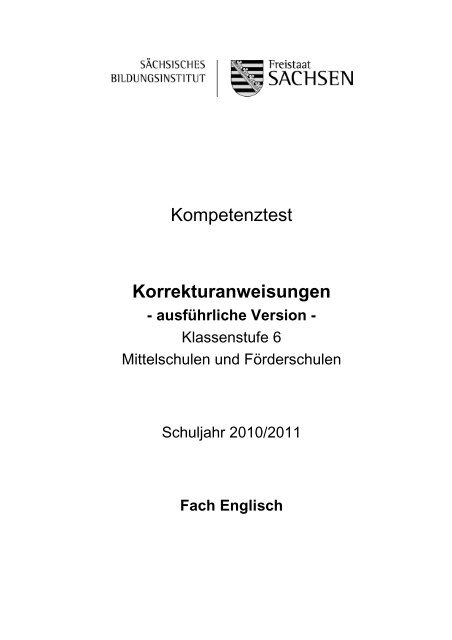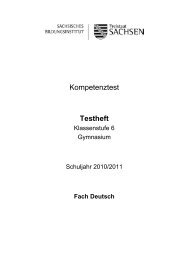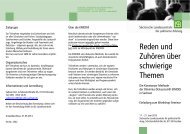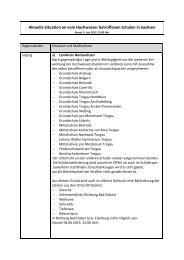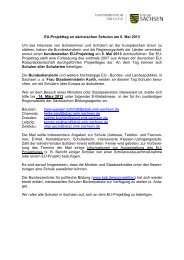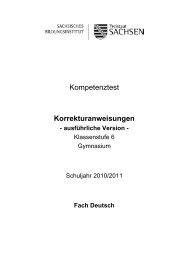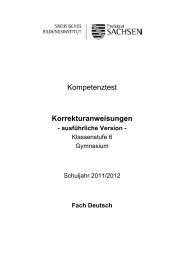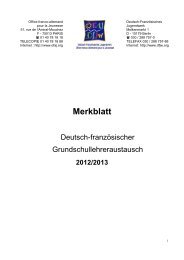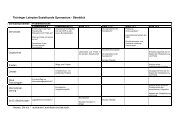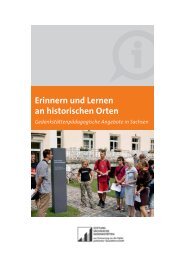Korrekturmanual B - Bildung
Korrekturmanual B - Bildung
Korrekturmanual B - Bildung
Create successful ePaper yourself
Turn your PDF publications into a flip-book with our unique Google optimized e-Paper software.
Kompetenztest<br />
Korrekturanweisungen<br />
- ausführliche Version -<br />
Klassenstufe 6<br />
Mittelschulen und Förderschulen<br />
Schuljahr 2010/2011<br />
Fach Englisch
In den Kompetenztests 2011 im Fach Englisch wird der Lernstand in drei<br />
Kompetenzbereichen - Hören, Lesen und Schreiben - getestet. Um eine einheitliche,<br />
standardisierte und objektive Bewertung der Aufgaben und damit eine Vergleichbarkeit<br />
zwischen den Schulen und Klassen zu gewährleisten, finden Sie hier für die einzelnen<br />
Aufgaben Korrekturanweisungen. Es empfiehlt sich, die Korrektur mit Kollegen bzw.<br />
Kolleginnen aus der Fachschaft durchzuführen. Halten Sie sich unbedingt an diesen<br />
Auswertungsschlüssel.<br />
Diese Korrekturanweisungen sind in zwei Teile unterteilt:<br />
Teil 1 für die Aufgaben zum Hörverstehen und Leseverstehen<br />
Teil 2 für die Aufgaben zum Schreiben<br />
Teil 1 Hörverstehen und Leseverstehen<br />
Im Testheft zum Hörverstehen und Leseverstehen werden Sie eine Reihe verschiedener<br />
Aufgaben finden. Die Mehrzahl sind geschlossene Aufgaben, andere sind halboffene<br />
Aufgaben.<br />
Während Sie bei geschlossenen Aufgaben keinen Ermessensspielraum haben,<br />
erfordern die halboffenen Aufgaben manchmal eine genauere Einarbeitung, um zu<br />
entscheiden, ab wann eine Lösung als richtig bzw. falsch zu bewerten ist. In der Regel ist<br />
der Ermessensspielraum aber sehr gering. Jedes Item wird einzeln bewertet.<br />
Wichtig: Allgemeine Hinweise zur Korrektur der Hörverstehens- und<br />
Leseverstehensaufgaben<br />
Kodierung:<br />
Bei der Auswertung müssen die Schülerantworten zunächst als „richtig“ oder „falsch“<br />
identifiziert werden. Es gibt keine Kategorie „teilweise richtig“.<br />
Die Anzahl der richtigen Lösungen pro Aufgabe wird zusammengefasst und als Ziffer<br />
(zwischen 0 und der maximalen Itemanzahl) ins Portal eingegeben.<br />
z.B. Task 1: Es sind maximal 7 richtige Lösungen möglich, davon hat der Schüler 3<br />
richtige Antworten, d.h. die Ziffer wird „3“ eingetragen.<br />
Worte, die in den Schlüsseln in Klammern erscheinen, sind für eine richtige Antwort<br />
nicht erforderlich. Alternative Antworten werden durch einen Schrägstrich (/)<br />
gekennzeichnet.<br />
Für eine korrekte Lösung ist es nicht erforderlich, mit einem vollständigen Satz zu<br />
antworten. Satzfragmente sind als korrekt zu bewerten, wenn sie alle<br />
geforderte Inhalte in vollem Umfang enthalten.<br />
Bitte beachten Sie, dass i. d. R. die Rechtschreibung für die Auswertung keine<br />
Rolle spielt. Man muss das Wort aber erkennen können und Verwechslungen mit<br />
anderen Wörtern dürfen nicht entstehen.<br />
Auf den folgenden Seiten finden Sie die Auswertungsschlüssel zu den Aufgaben / Items<br />
des Testhefts Listening and Reading<br />
Die entsprechenden Auswertungscodierungen werden dann in die Datenmaske<br />
eingetragen.
Heft MS/FÖS Lösungen / Booklet B keys Listening and Reading<br />
Listening Tasks<br />
Task 1 Key LC10 10<br />
1 c, 2 c, 3 b, 4 a, 5 d, 6 c, 7 b<br />
Task 2 Key LC21 10<br />
1 d, 2 a, 3 b, 4 d, 5 a<br />
Task 3 Key LC13 10<br />
1a, 2d, 3c, 4d<br />
Task 4 Key LC11 10<br />
0 Who is the birthday present for? A friend<br />
1 How old is the boy? 12<br />
2 What are his hobbies?<br />
3 What sport does he not like? football<br />
4 What sports does he like?<br />
5 How much do the goggles cost? (£) 9.99 (pounds)<br />
6 What colour are the goggles? yellow<br />
a) (playing) computer games<br />
b) (watching) TV [in any order]<br />
a) swimming<br />
b) hockey [in any order]
Task 5 Key LC 19 10<br />
0 When did the girl go on holiday? in winter<br />
1 Who went with her and her parents? brother<br />
2 How did the family get to Austria? (by) car<br />
3 How long did the journey take? 8 hours<br />
4<br />
What was the weather like?<br />
(2 answers)<br />
Any 2 of : sunny / blue sky / cold / lots of<br />
snow / -5°<br />
5 What sport did the girl do? (went) snowboarding<br />
Reading Tasks<br />
Task 6 Key RC02 10<br />
0 Who gets the letter? Emma<br />
1 When does Sarah get up? (at) 6.30 / six thirty / half (past) six<br />
2 How does she get to school? (by) bus / take(s) the bus<br />
3 Where does Sarah have her lunch? (at) home<br />
4<br />
5<br />
What does she do with her friends?<br />
Name two things.<br />
What happens between 7 pm and<br />
8.30? Name two things.<br />
a) & b)<br />
ANY 2 OF:-shop(ping) / meet / sport(s)<br />
a) play(s) a game...................................<br />
b) watch(es) TV .....................................
Task 7 Key RC04 10<br />
True False Not<br />
given<br />
0 Janet lives in Manchester. <br />
1 You can touch the animals in the children’s zoo. <br />
2 Parents can relax in the café. <br />
3 Janet likes the baby lions best. <br />
4 Whiggle and Piggle are her school friends. <br />
5 Wingy likes flying away. <br />
6 Janet has got a brother. <br />
7 Pat cries when the birds fly away. <br />
Task 8 Key RC32 10<br />
Task 9 Key RC24 10<br />
1 c, 2 d, 3 a, 4 c, 5 b<br />
Task 10 Key RC07 10<br />
1 d, 2 c, 3 a, 4 b, 5 c<br />
0 This ticket was for 16 th October. A<br />
1 This ticket was bought at half past eleven. E<br />
2 This ticket was for a student. D<br />
3 This ticket cost £20 B<br />
4 This ticket was for a church and museum. C<br />
5 This ticket was for the London Eye. E<br />
6 This ticket was for 8 th November.. D<br />
7 This ticket was for a Thursday. A<br />
8 This ticket was for the Tower of London. D
Task 11 Key RC15 10<br />
1) 3 or 4 times (a night)<br />
2) Any 2 of:- mother / father / sister<br />
3) 18 (years)<br />
4) Any 3 of:- (special) boots / fire pants / (a) hood / (a) helmet / mask / gloves<br />
5) (a) flight medic / medic on (a) helicopter<br />
6) call / phone 911<br />
Teil 2 Schreiben<br />
In den Lernstandserhebungen / Vergleichsarbeiten 2011 im Fach Englisch wird auch der<br />
Lernstand hinsichtlich des Kompetenzbereiches „Schreiben“ erhoben. Um dabei eine<br />
einheitliche, standardisierte und möglichst objektive Bewertung der Aufgaben zu<br />
gewährleisten, finden Sie hier ausführliche Korrekturanweisungen bzw. -hilfen, die in den<br />
Pilotierungen zu diesen Aufgaben erprobt wurden und sich als hilfreich herausgestellt<br />
haben.<br />
Für jede der drei zu bearbeitenden Aufgaben<br />
1. W02 10: Sundays (Level A1)<br />
2. W06 10: My best friend (Level A1+)<br />
3. W10 10: Dream pet (Level A2)<br />
wurde ein Assessment grid for writing tasks erstellt, das Sie als Korrekturvorlage für jede<br />
Schülerin/jeden Schüler benutzen können (muss dann jeweils kopiert werden).<br />
Dieses Assessment grid for writing tasks gliedert sich in zwei Teile:<br />
1. Eine Checkliste für Task Fulfilment<br />
2. Assessment<br />
Die Checkliste bietet Ihnen als Checklist for guidance only in tabellarischer Form die<br />
Möglichkeit, elementare Kriterien der Aufgabenerfüllung (Task Fulfilment) zu erfassen<br />
und dient – wie der Name schon sagt – nur als Hilfe (Checklist).<br />
Hier können Sie durch Abhaken oder Ankreuzen eintragen, ob die Lernenden die<br />
Einzelkriterien erfüllt haben (yes) oder nicht (no). Die angegebenen Kriterien resultieren<br />
aus den Antworten der Pilotierungen und dienen als Vorlage. Andere Aspekte, die die<br />
Lernenden einbringen und die für das Task Fulfilment relevant sind, können Sie in der<br />
Zeile Additional Information eintragen.<br />
Der Assessment-Teil bildet den eigentlichen Bewertungsteil. Dieser ist in zwei Teile<br />
gegliedert:<br />
1. Task Fulfillment / Communicative Effect Achieved<br />
2. Language
Im Teil Task Fulfilment / Communicative Effect Achieved sind alle Komponenten aus der<br />
Tabelle Checklist for guidance only zusammengefasst.<br />
Für die Bewertung von Task Fulfilment / Communicative Effect Achieved finden Sie<br />
detaillierte Anweisungen für jede einzelne Aufgabe auf dem Assessment grid und<br />
allgemeine Kriterien als Grundlage für Ihre Bewertung in der Spalte Task Fulfilment vom<br />
Rating Scale.<br />
Der Teil Language beinhaltet die Komponenten Organisation, Vocabulary und Grammar<br />
mit den angegebenen Untergliederungen, die jedoch bei den einzelnen Aufgaben<br />
unterschiedlich – je nach Aufgabenstellung – zur Anwendung kommen. Auch hier ist die<br />
jeweilige Gesamtbewertung nach den auf den Assessment Grids vorgegebenen<br />
Aufschlüsslungen zu bewerten.<br />
Bei der Bewertung der sprachlichen Leistung geht es darum, ob genug Sprache<br />
produziert wurde, um eine Bewertung vornehmen zu können.<br />
Die in der Aufgabe angegebene Wortzahl, ist nur als Hilfestellung für die Schülerinnen<br />
und Schüler gedacht, weder die Schüler noch Sie müssen die Wörter zählen.<br />
Durch die detaillierte Aufschlüsselung der einzelnen Bereiche erhalten Sie ein recht<br />
genaues Bild des sprachlichen Lernstandes Ihrer Lerngruppe. Als Voraussetzungen für<br />
die Einzelkomponenten Organisation, Vocabulary und Grammar mit ihren angegebenen<br />
Untergliederungen wurde ein Bewertungsraster – Rating Scale – erstellt, das nach den<br />
Stufen des GER gegliedert ist (Level A1 und A2). Dieses Raster beschreibt<br />
Minimalvoraussetzungen.<br />
Die für die Bewertung nötigen Dokumente (Assessment Grids und Rating Scales)<br />
finden Sie im Anhang.<br />
Wir empfehlen Ihnen, drei oder vier Schülerantworten zusammen mit Kolleginnen und<br />
Kollegen der Fachschaft Englisch zu bewerten und Ihre Ergebnisse und Ihre Anwendung<br />
der Rating Scales zu diskutieren. Unsere Erfahrungen in der Pilotierung haben gezeigt,<br />
dass man sich relativ schnell mit den Rating Scales vertraut machen kann und dass<br />
Lehrer sie in kurzer Zeit objektiv und akkurat verwenden können.<br />
Es muss betont werden, dass Fehler weder unterstrichen, noch korrigiert, noch gezählt<br />
werden müssen. Man liest den Text des Schülers und bewertet ihn anhand der<br />
Deskriptoren in den Rating Scales. Hierbei muss man aber auf das Niveau der Aufgabe<br />
(A1 oder A2) achten und die für die Aufgabe und das Kompetenzniveau relevante<br />
Deskriptoren benutzen. Die für bestimmte Aufgaben nicht relevanten Kriterien sind in den<br />
Assessment grids grau schattiert und erscheinen nicht in der Bewertungsmaske, wo Sie<br />
Ihre Ergebnisse eintragen.<br />
Zur Orientierung finden Sie hier drei Beispiele von Schülerantworten zu einer A1 +<br />
Aufgabe aus der Pilotierung und eine Bewertung einschließlich Begründung.<br />
Bitte auf keinen Fall die Fehler zählen! In der Bewertung geht es hier um Kriterien und<br />
Kompetenzen, nicht um Fehlerquotienten!
Nach dem Lesen des vom Schüler geschriebenen Textes ist es Ihnen freigestellt, ob Sie<br />
die Assessment Grids zuerst ausfüllen, was wir Ihnen empfehlen, oder ob Sie Ihre<br />
Codierungen direkt in die Ergebnismaske eintragen.<br />
Vergleichen Sie bitte Schülertexte nicht miteinander! Bewerten/codieren Sie jeden<br />
Schülertext für sich. Bemerkungen wie „Schüler B ist aber eindeutig besser als Schüler<br />
A“ sind bei einer Codierung nicht relevant. Sie bewerten/codieren den Schülertext in<br />
Bezug auf die Deskriptoren des relevanten Kompetenzniveaus und nicht in Bezug auf die<br />
Leistungen anderer Schüler.<br />
Denken Sie bitte daran, wenn die Schreibaufgabe als A1 bezeichnet ist, sind nur die A1<br />
Deskriptoren zu verwenden. Wenn die Aufgabe als A1+ bezeichnet ist, kann man bei<br />
„Language“ die Schülerleistung nach A1 (Codierung 1) oder nach A2 (Codierung 2)<br />
bewerten, d.h. man benutzt die A1 und A2 Deskriptoren. Bei „task fulfilment“ dagegen<br />
gelten bei A1+ Aufgaben nur die A1 task fulfilment Deskriptoren. Bei einer A2 Aufgabe<br />
sind im Bereich „Task fulfilment“ nur die A2 Deskriptoren zu verwenden, aber im Bereich<br />
„Language“ kann man (mit Ausnahme von structure and thematic development) die A1<br />
Deskriptoren (Codierung 1) und/oder die A2 Deskriptoren (Codierung 2) benutzen.<br />
Als Lehrer sind wir oft dazu geneigt, sehr kritisch mit Fehlern umzugehen und sie als<br />
Grundlage einer negativen Einschätzung der Schülerleistung zu betrachten. Die<br />
Deskriptoren des GER gehen aber davon aus, dass Fehler gemacht werden und<br />
bewerten sie deshalb in Bezug auf das Verständnis des Textes. Sie dürfen die<br />
Deskriptoren nicht aus dem Auge verlieren und nicht vergessen, dass A1 und A2 in der<br />
Kategorie „elementare Sprachverwendung“ angesiedelt sind. Die von Schülern<br />
geschriebenen Texte werden wahrscheinlich nicht fehlerfrei sein, können aber trotzdem<br />
eindeutig den Deskriptoren der Kompetenzniveaus zugeordnet werden.<br />
Commentary<br />
Preamble:<br />
As a basis for the assessment of the pupils’ scripts one should ask oneself whether the<br />
script would be understood by “a sympathetic, educated native speaker of English who<br />
does not understand German”, i.e. one should be prepared to make an effort to<br />
understand what the pupil has written, but a pupil’s use of German lexis would, for such<br />
an individual, impede understanding. Our fictitious native speaker would be most unlikely<br />
to resort to phonetic transcriptions, except in isolated cases, to understand the text.<br />
Please note that the task WR06 10, which has been used in the following commentaries,<br />
has been slightly changed as a result of the trials. You will notice that the bullet-point<br />
“why you like him/her” has been removed from the versions in the test booklets used by<br />
your pupils and, therefore, in the assessment grid made available to you and used in<br />
these commentaries. (The piloting of the tasks demonstrated that there was too much<br />
overlap between “why you like him/her” and “why he/she is your best friend”. Only one of<br />
the two bullets was necessary for pupils to produce the language required.)
Pupil 1
Pupil 1<br />
Assessment grid for writing task WR06 10 Level A1+<br />
My Best Friend<br />
Checklist for guidance only<br />
TASK FULFILMENT<br />
▲relevant content points<br />
NO YES<br />
best friend’s name <br />
best friend’s age <br />
what best friend looks like <br />
what like doing together <br />
why he/she is best friend <br />
(additional information)<br />
▲Text type<br />
<br />
prose text (short sentences)<br />
▲Target audience<br />
<br />
competition judges (peers &<br />
adults)<br />
<br />
-----------------------------------------------------------------------------------------------------------------<br />
ASSESSMENT<br />
TASK FULFILMENT /<br />
COMMUNICATIVE EFFECT ACHIEVED<br />
0 1<br />
<br />
0 = the criteria 1, 2, 3, 4 and 5 on the assessment scale for A1 are NOT fulfilled<br />
1 = the criteria 1, 2, 3, 4 and 5 on the assessment scale for A1 are fulfilled<br />
▲Organisation<br />
LANGUAGE 0 1 2<br />
- structure and thematic development <br />
- cohesion <br />
▲Vocabulary<br />
- range <br />
- accuracy <br />
▲Grammar<br />
- range <br />
- accuracy <br />
0 = below the level A1<br />
1 = at the level A1 (N.B code 1 is not to be used for “structure and thematic development”)<br />
2 = at the level A2
Commentary:<br />
Pupil 1<br />
Pupils number one’s script may, if we are not familiar with certain children’s TV channels and<br />
programmes, send us rushing to our search engines to find out who or what “Spongebob” is!<br />
Having checked, we may not necessarily interpret it as a compliment to Michelle, but it is a<br />
perfectly acceptable response to the bullet “what he/she looks like” – it may not be one which<br />
task-writers and teachers expecting a description might have anticipated, but it is not wrong.<br />
“Although some difficulty is likely to be experienced by the reader” (point 5) our sympathetic,<br />
educated native speaker is likely to be able to understand “we like doing together shoppen”<br />
and most people would quickly realize that “Karakter” is supposed to be “character” – an<br />
orthographically complex word even for native-speaker children. We can, therefore, say that<br />
the criteria 1, 2, 3, 4 and 5 at A1 have been fulfilled and we can award code 1.<br />
As this is an A1+ task, we can assess the language at A1 or A2. As can be seen from the<br />
assessment grid, we can only, however, assess structure and thematic development at A2.<br />
This pupil’s script is almost a perfect match to that part of the descriptor which is in italics; we<br />
can, therefore, tick the A2 box. In terms of cohesion, there is, sadly, not one single<br />
conjunction in the pupil’s text and, although the pupil is able to use pronouns, the text<br />
matches neither the A2 nor the A1 descriptor. We would, therefore, have to use the 0 coding.<br />
That degree of divergence between the two organisation sub-sections is unusual but not<br />
impossible.<br />
When assessing the pupil’s range of vocabulary, one needs to refer to the definitions of<br />
“elementary” and “basic” in the rating scale glossary. On balance this pupil’s understanding<br />
and use of lexis is closer to the A2 descriptor than to the A1 descriptor, but this is not an easy<br />
decision. In terms of vocabulary accuracy, again, on balance, the A2 descriptor, perhaps<br />
contrary to our initial reaction, seems to offer the best fit.<br />
If we look at the range of grammar, the pupil’s performance clearly does not match the A2<br />
descriptor. The A1 descriptor is, however, a good match here. As it is stated that “accuracy<br />
should be treated in relation to range”, we are probably best advised to establish a clear link<br />
between the two here as “the control of simple structures and patterns” is clearly to be<br />
understood in the context of the structures described in A2 grammatical range – in those<br />
terms this pupil is only at A1.<br />
This candidate has relied heavily on the bullet points – to the extent that he/she has lifted<br />
those structures and the lexis and, in doing so, may well have restricted his/her ability to<br />
demonstrate a more varied use of lexis and syntax. One has a feeling that this candidate<br />
could be capable of performing at a higher level on an A2 task which offers more scope to<br />
branch out from the structures and lexis used in the bullets. One suspects that, if there had<br />
been a full stop at the end of each bullet, the candidate would have punctuated his/her text<br />
correctly!
Pupil 2
Pupil 2<br />
Assessment grid for writing task WR06 10 Level A1+<br />
My Best Friend<br />
Checklist for guidance only<br />
TASK FULFILMENT<br />
▲relevant content points<br />
NO YES<br />
best friend’s name <br />
best friend’s age <br />
what best friend looks like <br />
what like doing together <br />
why he/she is best friend <br />
(additional information)<br />
▲Text type<br />
<br />
prose text (short sentences)<br />
▲Target audience<br />
<br />
competition judges (peers &<br />
adults)<br />
<br />
-----------------------------------------------------------------------------------------------------------------<br />
ASSESSMENT<br />
TASK FULFILMENT /<br />
COMMUNICATIVE EFFECT ACHIEVED<br />
0 1<br />
<br />
0 = the criteria 1, 2, 3, 4 and 5 on the assessment scale for A1 are NOT fulfilled<br />
1 = the criteria 1, 2, 3, 4 and 5 on the assessment scale for A1 are fulfilled<br />
▲Organisation<br />
LANGUAGE 0 1 2<br />
- structure and thematic development <br />
- cohesion <br />
▲Vocabulary<br />
- range <br />
- accuracy <br />
▲Grammar<br />
- range <br />
- accuracy <br />
0 = below the level A1<br />
1 = at the level A1 (N.B code 1 is not to be used for “structure and thematic development”)<br />
2 = at the level A2
Commentary:<br />
Pupil 2.<br />
It is rare to find a pupil’s script which fits perfectly into all the A1 or A2 descriptors and pupil<br />
two’s script is no exception. After a most promising first two lines we encounter our first<br />
problem where the candidate has misunderstood “what he/she looks like” and this leads to<br />
a general insecurity on how to proceed with the text. There is clearly no physical description<br />
of the friend but the other task fulfilment boxes (i.e. 5 out of 6) can be ticked “Yes” and,<br />
despite our difficulties in places, points 1 to 5 on the rating scale are fulfilled, i.e. task<br />
fulfilment at A1 has been achieved.<br />
We may react totally negatively to the pupil’s use of “why” instead of “because” but with the<br />
addition of certain pauses and the correct punctuation this would be perfectly acceptable in<br />
everyday (spoken) English – “She is my best friend. Why? We like music and we have the<br />
same hobbies.” Admittedly our “sympathetic, educated native speaker who doesn’t<br />
understand German” would be incapable of making sense of “a gleichen hobbys” but “we<br />
likes music” would present few problems of comprehension.<br />
Moving now to the assessment of language, given that the pupil has indeed produced<br />
enough language, we are left with three possible codes for this A1 task – 0, 1 or 2. In terms<br />
of structure and thematic development the script matches the A2 descriptor well. Looking at<br />
cohesion, the pupil’s use of “and” provides a good match with the A1 descriptor. (It must be<br />
noted here that the descriptor states “ … ‘and’ or ‘then’”.)<br />
A close look at the definition of “elementary vocabulary” could well justify placing this<br />
candidate’s performance in vocabulary range at A2. The descriptor at A2 for vocabulary<br />
accuracy contains an interesting and significant difference from the A2 descriptor for<br />
vocabulary range in that for accuracy we read “shows control … of elementary vocabulary”;<br />
this, coupled with those sections in italics, fully justifies using the A2 coding here.<br />
Despite the restrictions imposed by the task, it is possible to use a variety of tenses and<br />
modals here. This candidate’s script, however, restricts itself to the simple present and<br />
corresponds closely to the A1 descriptor for range of grammar. Once again, given that<br />
“accuracy should be treated in relation to range” and that we have established that<br />
grammar range is A1, it would be an extraordinary script that could justify an A1 for range<br />
but an A2 for accuracy. That is not the case here, so we can link the two and award A1 for<br />
accuracy as well.
Pupil 3
Pupil 3<br />
Assessment grid for writing task WR06 10 Level A1+<br />
My Best Friend<br />
Checklist for guidance only<br />
TASK FULFILMENT<br />
▲relevant content points<br />
NO YES<br />
best friend’s name <br />
best friend’s age <br />
what best friend looks like <br />
what like doing together <br />
why he/she is best friend <br />
(additional information)<br />
▲Text type<br />
<br />
prose text (short sentences)<br />
▲Target audience<br />
<br />
competition judges (peers &<br />
adults)<br />
<br />
-----------------------------------------------------------------------------------------------------------------<br />
ASSESSMENT<br />
TASK FULFILMENT /<br />
COMMUNICATIVE EFFECT ACHIEVED<br />
0 1<br />
<br />
0 = the criteria 1, 2, 3, 4 and 5 on the assessment scale for A1 are NOT fulfilled<br />
1 = the criteria 1, 2, 3, 4 and 5 on the assessment scale for A1 are fulfilled<br />
▲Organisation<br />
LANGUAGE 0 1 2<br />
- structure and thematic development <br />
- cohesion <br />
▲Vocabulary<br />
- range <br />
- accuracy <br />
▲Grammar<br />
- range <br />
- accuracy <br />
0 = below the level A1<br />
1 = at the level A1 (N.B code 1 is not to be used for “structure and thematic development”)<br />
2 = at the level A2
Commentary:<br />
Pupil 3<br />
Here we have another example of a pupil who has simply but effectively worked their<br />
way through the bullet-points, indeed relying on theses to such an extent that the<br />
bullet-points have been regarded as questions to which the pupil has merely supplied<br />
a subordinate clause as an answer. Despite that and despite the amusing image<br />
created by “He has a black hair … .”, we can tick all the “Yes” boxes on the check-list<br />
and award an A1 code for task fulfilment.<br />
The script clearly matches the A2 descriptor for structure and thematic development,<br />
but the category cohesion is rather problematic here. The pupil can indeed use both<br />
the conjunctions “and” and “because”, and employ pronouns correctly – all features<br />
of the A2 descriptor. However, as we have already noted, the pupil has clearly<br />
treated the bullets as questions and has replied to those questions, perhaps as<br />
he/she would orally, by simply using the subordinate clauses beginning with<br />
“because” and one could argue that this does not perform a linking function but rather<br />
impedes the cohesion of the written text. Perhaps the section of the A2 descriptor in<br />
italics will tip the balance in favour of A2, “Cohesive devices are not yet found<br />
throughout the text; their limited control may sometimes impede communication.”<br />
One has a feeling that the linguistic ability of this pupil may be causing him/her to<br />
look down upon this task as being beneath his/her ability and, therefore, despite<br />
his/her knowledge of cohesive devices, may be taking the least time-consuming<br />
option to complete the task. We can, however, only reach a judgement on the script<br />
in front of us and its relationship to the A1 and A2 descriptors.<br />
The script presents us with similar problems in the vocabulary categories. Perhaps<br />
the fact that the task straddles the border between A1 and A2 also leads to pupils’<br />
scripts doing the same. Although this script reads quite well and one could initially<br />
tend towards an A2 assessment of vocabulary range as a result of that, if we look<br />
closely at the lexis, there are perhaps only “together” (lifted from the bullets?), “talks”<br />
and “always” which go beyond the glossary definition of elementary vocabulary. Yet<br />
perhaps it is the use of adjectives, articles (not all correctly), pronouns, conjunctions<br />
and adverbs which can enable us to say this performance does, after all, slip into A2<br />
territory – the use of lexis is not in “isolated words or phrases” but goes beyond that.<br />
Having made that difficult decision we can more readily award an A2 coding for<br />
accuracy – indeed the script offers a good match to the A2 descriptor.<br />
Moving on to the range of grammar section, the pupil’s script seems to be a good<br />
match with the A1 descriptor – possibly at the top end of A1 but not quite nudging<br />
into A2 – the opportunity to use more varied structures has not been taken up.<br />
Consequently, when linking accuracy to range, we can also award an A1 coding for<br />
accuracy.
Assessment grid for writing task WR02 10 Level A1<br />
Booklet MS/FÖS Task 1 Sundays<br />
Checklist for guidance only<br />
TASK FULFILMENT<br />
▲relevant content points<br />
(salutation)<br />
breakfast<br />
activities in the morning<br />
activities in the afternoon<br />
(additional information)<br />
(valediction)<br />
▲Text type<br />
prose / article / notes<br />
▲Target audience<br />
Magazine / newspaper readers<br />
(age neutral or same peer group)<br />
NO YES<br />
-----------------------------------------------------------------------------------------------------------------<br />
ASSESSMENT<br />
TASK FULFILMENT /<br />
COMMUNICATIVE EFFECT ACHIEVED<br />
0 1<br />
0 = the criteria 1, 2, 4 and 5 on the assessment scale for A1 are NOT fulfilled<br />
1 = the criteria 1, 2, 4 and 5 on the assessment scale for A1 are fulfilled<br />
▲Organisation<br />
LANGUAGE 0 1<br />
- structure and thematic development<br />
- cohesion<br />
▲Vocabulary<br />
- range<br />
- accuracy<br />
▲Grammar<br />
- range<br />
- accuracy<br />
0 = below the level A1<br />
1 = at the level A1
Assessment grid for writing task WR06 10 Level A1+<br />
Booklet MS/FÖS Task 2 My Best Friend<br />
Checklist for guidance only<br />
TASK FULFILMENT<br />
▲relevant content points<br />
best friend’s name<br />
best friend’s age<br />
what best friend looks like<br />
what like doing together<br />
why he/she is best friend<br />
(additional information)<br />
▲Text type<br />
prose text (short sentences)<br />
▲Target audience<br />
competition judges (peers &<br />
adults)<br />
NO YES<br />
-----------------------------------------------------------------------------------------------------------------<br />
ASSESSMENT<br />
TASK FULFILMENT /<br />
COMMUNICATIVE EFFECT ACHIEVED<br />
0 1<br />
0 = the criteria 1, 2, 3, 4 and 5 on the assessment scale for A1 are NOT fulfilled<br />
1 = the criteria 1, 2, 3, 4 and 5 on the assessment scale for A1 are fulfilled<br />
▲Organisation<br />
LANGUAGE 0 1 2<br />
- structure and thematic development<br />
- cohesion<br />
▲Vocabulary<br />
- range<br />
- accuracy<br />
▲Grammar<br />
- range<br />
- accuracy<br />
0 = below the level A1<br />
1 = at the level A1 (N.B code 1 is not to be used for “structure and thematic development”)<br />
2 = at the level A2
Assessment grid for writing task WR10 10 Level A2<br />
Booklet MS/FÖS Task 3 Dream Pet<br />
Checklist for guidance only<br />
TASK FULFILMENT<br />
▲relevant content points<br />
what dream pet is<br />
why you like it<br />
what it looks like<br />
what it eats and/or drinks<br />
where it sleeps<br />
what you can do with it<br />
(additional information)<br />
▲Text type<br />
prose text (sentences)<br />
▲Target audience<br />
competition judges (likely adults)<br />
NO YES<br />
-----------------------------------------------------------------------------------------------------------------<br />
ASSESSMENT<br />
TASK FULFILMENT /<br />
COMMUNICATIVE EFFECT ACHIEVED<br />
0 1<br />
0 = the criteria 1, 2, 3, 4 and 5 on the assessment scale for A2 are NOT fulfilled<br />
1 = the criteria 1, 2, 3, 4 and 5 on the assessment scale for A2 are fulfilled<br />
▲Organisation<br />
LANGUAGE 0 1 2<br />
- structure and thematic development<br />
- cohesion<br />
▲Vocabulary<br />
- range<br />
- accuracy<br />
▲Grammar<br />
- range<br />
- accuracy<br />
0 = below the level A1<br />
1 = at the level A1 (N.B code 1 is not to be used for “structure and thematic development”)<br />
2 = at the level A2
RATING SCALE<br />
KOMPETENZTESTS 2011 – KLASSENSTUFE 6<br />
WRITING<br />
Descriptors state the expectations for different criteria, targeting levels A1 and A2.<br />
Remarks in Italics/blue are rating guidelines and state additional features which are characteristic for that level.<br />
Glossary:<br />
1<br />
Elementary vocab: names, dates, nationality and words that express needs within survival situations, surroundings, limited social<br />
demands, food, lodging, transport, etc.<br />
2<br />
Basic vocabulary refers to the so called Grundwortschatz (roughly encompassing the 2000 most frequently used words)<br />
3<br />
Local errors are grammatical errors within one sentence which do not hinder understanding [e.g. mixing up of tenses, forgetting to<br />
mark agreement, problems with subordinate clauses, errors in word order]. It is usually clear what the writer wants to express.<br />
4<br />
Global errors are those grammatical errors which hinder understanding at the sentence level.<br />
5<br />
Non-impeding errors are those lexical / spelling errors which can be resolved spontaneously.<br />
6<br />
Impeding errors are those lexical / spelling errors which are irresolvable or take a great deal of effort to resolve.
Level Task fulfilment Organisation<br />
A2<br />
1. Most of the expected content<br />
points (2/2, 2/3, 3/4, 4/5, 5/6,<br />
5/7, 6/8, 7/9, 7/10) are<br />
mentioned.<br />
2. The majority of the ideas are<br />
relevant to the task<br />
3. Register and tone are<br />
appropriate for the target<br />
audience; simple everyday<br />
polite forms are shown [if<br />
applicable].<br />
4. Meets text type requirements<br />
[i.e. following a standard<br />
format, if applicable]<br />
5. Communicative effect mainly<br />
achieved i.e. the message is<br />
mainly conveyed although<br />
some difficulty may be<br />
experienced by the reader.<br />
Structure / Thematic development<br />
Text shows logical order but there might be<br />
“jumpiness” in the thematic development or the<br />
thematic development might be illogical in some<br />
parts. The end might be missing.<br />
Tells a story or describes something in a simple<br />
list of points [uses task bullets to structure text].<br />
Text is not usually organised in paragraphs.<br />
Language / Cohesion<br />
Links a series of simple phrases / sentences /<br />
groups of words using simple cohesive devices,<br />
such as articles, pronouns and connectors [the<br />
most frequent ones like ‘and’, ‘but’, ‘because’,<br />
‘so’, ‘then’, ‘after’].<br />
Cohesive devices are not yet found throughout<br />
the text; their limited control may sometimes<br />
impede communication.<br />
Vocabulary<br />
(Accuracy should be treated in relation to range)<br />
Range<br />
Has a basic 2 range of vocabulary but is able to<br />
express everyday communicative needs.<br />
Accuracy<br />
Shows control [i.e. adequate and appropriate<br />
use] of elementary 1 vocabulary.<br />
Non-impeding 5 errors may occur frequently.<br />
Some impeding 6 errors may occur.<br />
Spelling errors may often occur.<br />
Performance may show noticeable mother<br />
tongue influence.<br />
Level Task fulfilment Organisation Vocabulary<br />
(Accuracy should be treated in relation to range)<br />
A1<br />
1. Most of the expected content<br />
points (2/2, 2/3, 3/4, 4/5, 5/6,<br />
5/7, 6/8, 7/9, 7/10) are<br />
mentioned.<br />
2. The majority of the ideas are<br />
relevant to the task.<br />
3. Register and tone are<br />
appropriate for the target<br />
audience; the simplest<br />
everyday polite forms are<br />
shown [if applicable].<br />
4 Meets text type requirements<br />
[i.e. following standard format<br />
such as completing a form,<br />
writing a list of points, etc. [if<br />
applicable].<br />
5 Communicative effect mainly<br />
achieved i.e. the message is<br />
mainly conveyed although<br />
some difficulty is likely to be<br />
experienced by the reader.<br />
Language / Cohesion<br />
Links words or groups of words with very basic<br />
linear connectors like ‘and’ or ‘then’. Apart from<br />
that, words/groups of words are not connected<br />
by cohesive ties.<br />
Range<br />
Shows an elementary 1 vocabulary range of<br />
isolated words and phrases restricted to<br />
particular concrete situations.<br />
Accuracy<br />
Shows control of a few elementary words.<br />
Words beyond the targeted level are likely to<br />
be used inaccurately / inappropriately.<br />
Most frequently used words may be correctly<br />
spelled, but words beyond that are exposed to<br />
spelling errors.<br />
Performance may show serious mother tongue<br />
influences.<br />
Documents consulted: Manual for linking examination to the CEFR; Into Europe Rating Scale; CEFR; DESI Rating Scales; IQB Rating Scales<br />
Grammar<br />
(Accuracy should be treated in relation to range)<br />
Range<br />
Uses some simple structures [such as<br />
present/ past/ future; simple modals, e.g.<br />
‘can/may/must’; auxiliaries, e.g. ‘to be/have’]<br />
and some simple sentence patterns [e.g.<br />
questions/answers, negatives/positives,<br />
commands, suggestions].<br />
Accuracy<br />
Shows control of a few simple structures and<br />
patterns.<br />
Local errors 3 may occur frequently [i.e. in<br />
nearly every sentence].<br />
Some global errors 4 are likely to occur.<br />
Performance may show noticeable mother<br />
tongue influence.<br />
Grammar<br />
(Accuracy should be treated in relation to range)<br />
Range<br />
Shows only a few simple grammatical<br />
structures (such as simple present tense,<br />
simple modals) and phrase / sentence patterns<br />
(such as simple noun + verb phrases, simple<br />
sentences / SPO) in a learnt repertoire.<br />
Accuracy<br />
Forms simple phrases (syntax) correctly.<br />
Any structures beyond the targeted level are<br />
likely to be used inaccurately which may<br />
hinder understanding.<br />
Performance may show serious mother tongue<br />
influences.
RATING SCALE<br />
Kompetenztest 2011 - Klassenstufe 6<br />
WRITING<br />
Descriptors state the expectations for different criteria, targeting levels A1 and A2.<br />
Remarks in Italics/blue are rating guidelines and state additional features which are characteristic for that level.<br />
Glossary:<br />
1<br />
Elementary vocab: names, dates, nationality and words that express needs within survival situations, surroundings, limited social<br />
demands, food, lodging, transport, etc.<br />
2<br />
Basic vocabulary refers to the so called Grundwortschatz (roughly encompassing the 2000 most frequently used words)<br />
3<br />
Local errors are grammatical errors within one sentence which do not hinder understanding [e.g. mixing up of tenses, forgetting to<br />
mark agreement, problems with subordinate clauses, errors in word order]. It is usually clear what the writer wants to express.<br />
4<br />
Global errors are those grammatical errors which hinder understanding at the sentence level.<br />
5<br />
Non-impeding errors are those lexical / spelling errors which can be resolved spontaneously.<br />
6<br />
Impeding errors are those lexical / spelling errors which are irresolvable or take a great deal of effort to resolve.
Level Task fulfilment Organisation<br />
A2<br />
1. Most of the expected content<br />
points (2/2, 2/3, 3/4, 4/5, 5/6,<br />
5/7, 6/8, 7/9, 7/10) are<br />
mentioned.<br />
2. The majority of the ideas are<br />
relevant to the task<br />
3. Register and tone are<br />
appropriate for the target<br />
audience; simple everyday<br />
polite forms are shown [if<br />
applicable].<br />
4. Meets text type requirements<br />
[i.e. following a standard<br />
format, if applicable]<br />
5. Communicative effect mainly<br />
achieved i.e. the message is<br />
mainly conveyed although<br />
some difficulty may be<br />
experienced by the reader.<br />
Structure / Thematic development<br />
Text shows logical order but there might be<br />
“jumpiness” in the thematic development or the<br />
thematic development might be illogical in some<br />
parts. The end might be missing.<br />
Tells a story or describes something in a simple<br />
list of points [uses task bullets to structure text].<br />
Text is not usually organised in paragraphs.<br />
Language / Cohesion<br />
Links a series of simple phrases / sentences /<br />
groups of words using simple cohesive devices,<br />
such as articles, pronouns and connectors [the<br />
most frequent ones like ‘and’, ‘but’, ‘because’,<br />
‘so’, ‘then’, ‘after’].<br />
Cohesive devices are not yet found throughout<br />
the text; their limited control may sometimes<br />
impede communication.<br />
Vocabulary<br />
(Accuracy should be treated in relation to range)<br />
Range<br />
Has a basic 2 range of vocabulary but is able to<br />
express everyday communicative needs.<br />
Accuracy<br />
Shows control [i.e. adequate and appropriate<br />
use] of elementary 1 vocabulary.<br />
Non-impeding 5 errors may occur frequently.<br />
Some impeding 6 errors may occur.<br />
Spelling errors may often occur.<br />
Performance may show noticeable mother<br />
tongue influence.<br />
Level Task fulfilment Organisation Vocabulary<br />
(Accuracy should be treated in relation to range)<br />
A1<br />
1. Most of the expected content<br />
points (2/2, 2/3, 3/4, 4/5, 5/6,<br />
5/7, 6/8, 7/9, 7/10) are<br />
mentioned.<br />
2. The majority of the ideas are<br />
relevant to the task.<br />
3. Register and tone are<br />
appropriate for the target<br />
audience; the simplest<br />
everyday polite forms are<br />
shown [if applicable].<br />
4 Meets text type requirements<br />
[i.e. following standard format<br />
such as completing a form,<br />
writing a list of points, etc. [if<br />
applicable].<br />
5 Communicative effect mainly<br />
achieved i.e. the message is<br />
mainly conveyed although<br />
some difficulty is likely to be<br />
experienced by the reader.<br />
Language / Cohesion<br />
Links words or groups of words with very basic<br />
linear connectors like ‘and’ or ‘then’. Apart from<br />
that, words/groups of words are not connected<br />
by cohesive ties.<br />
Range<br />
Shows an elementary 1 vocabulary range of<br />
isolated words and phrases restricted to<br />
particular concrete situations.<br />
Accuracy<br />
Shows control of a few elementary words.<br />
Words beyond the targeted level are likely to<br />
be used inaccurately / inappropriately.<br />
Most frequently used words may be correctly<br />
spelled, but words beyond that are exposed to<br />
spelling errors.<br />
Performance may show serious mother tongue<br />
influences.<br />
Grammar<br />
(Accuracy should be treated in relation to range)<br />
Range<br />
Uses some simple structures [such as<br />
present/ past/ future; simple modals, e.g.<br />
‘can/may/must’; auxiliaries, e.g. ‘to be/have’]<br />
and some simple sentence patterns [e.g.<br />
questions/answers, negatives/positives,<br />
commands, suggestions].<br />
Accuracy<br />
Shows control of a few simple structures and<br />
patterns.<br />
Local errors 3 may occur frequently [i.e. in<br />
nearly every sentence].<br />
Some global errors 4 are likely to occur.<br />
Performance may show noticeable mother<br />
tongue influence.<br />
Grammar<br />
(Accuracy should be treated in relation to range)<br />
Range<br />
Shows only a few simple grammatical<br />
structures (such as simple present tense,<br />
simple modals) and phrase / sentence patterns<br />
(such as simple noun + verb phrases, simple<br />
sentences / SPO) in a learnt repertoire.<br />
Accuracy<br />
Documents consulted: Manual for linking examination to the CEFR; Into Europe Rating Scale; CEFR; DESI Rating Scales; IQB Rating Scales<br />
Forms simple phrases (syntax) correctly.<br />
Any structures beyond the targeted level are<br />
likely to be used inaccurately which may<br />
hinder understanding.<br />
Performance may show serious mother tongue<br />
influences.


